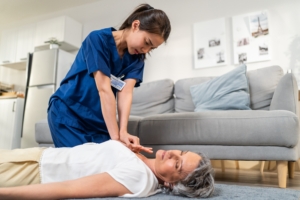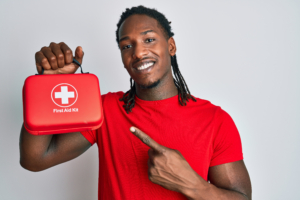
Elderly First Aid & CPR: Essential Knowledge for Caregivers
Caring for elderly individuals requires specialized knowledge and skills to address their unique health needs and vulnerabilities. Here’s a breakdown of essential first aid and CPR skills for elderly care, ensuring you are well-prepared for emergencies.
Recognizing and Responding to Emergencies
Assessing the Situation: Quickly and calmly assess the situation. Ensure the scene is safe. If the person is unresponsive or not breathing, immediate action is necessary.
Calling for Help: Call emergency services immediately if the person is unresponsive or not breathing. Provide clear information about the person’s condition and your location.
CPR for Elderly Adults
Performing CPR:
- Check for Responsiveness: Gently tap the person and shout to see if they respond.
- Positioning: Place the person on a firm, flat surface.
- Chest Compressions: Place the heel of one hand on the center of the chest, and the other hand on top. Compress about 2 inches deep at a rate of 100-120 compressions per minute.
- Rescue Breaths: After every 30 compressions, give 2 rescue breaths. Tilt the person’s head back slightly, pinch their nose, and cover their mouth with yours, giving a gentle breath until you see the chest rise.
Managing Choking
Choking Relief for Elderly Adults:
- Assess the Situation: If the person is unable to cry, cough, or breathe, they may be choking.
- Back Blows: Stand behind the person and provide up to 5 firm back blows between the shoulder blades.
- Abdominal Thrusts: If back blows are not effective, stand behind the person and give up to 5 abdominal thrusts (Heimlich maneuver).
Additional Elderly First Aid Skills
Managing Wounds:
- Minor Cuts and Scrapes: Clean with water, apply an antibiotic ointment, and cover with a sterile bandage.

- Severe Bleeding: Apply firm pressure with a clean cloth or bandage to control bleeding.
Treating Burns:
- Minor Burns: Cool under running water for at least 10 minutes. Cover with a sterile, non-stick dressing.
- Severe Burns: Do not remove any clothing stuck to the burn. Cover with a clean cloth and seek emergency medical assistance.
Recognizing and Responding to Common Illnesses
Heart Attack: Recognize symptoms like chest pain, shortness of breath, and nausea. Call emergency services immediately and provide aspirin if the person is not allergic.
Stroke: Use the FAST method (Face drooping, Arm weakness, Speech difficulties, Time to call 911) to identify and respond to stroke symptoms.
Managing Diabetic Emergencies:
- Hypoglycemia (Low Blood Sugar): Give the person 15-20 grams of fast-acting sugar (like juice or glucose tablets). Recheck blood sugar after 15 minutes and repeat if necessary.
- Hyperglycemia (High Blood Sugar): Seek medical help if the person is showing signs of high blood sugar and is unresponsive or unable to manage it themselves.
Managing Seizures:
- Protect the Person: Move objects away to prevent injury.
- Do Not Restrain: Allow the seizure to run its course and time it.
- Aftercare: Once the seizure ends, check for injuries and place the person in the recovery position if they are unresponsive but breathing.
Managing Angina: Recognize symptoms similar to a heart attack. Help the person take their prescribed medication, such as nitroglycerin. Call emergency services if the pain does not subside.
Managing Shock: Lay the person down, elevate their legs, and keep them warm with a blanket. Reassure and monitor their condition until help arrives.
Managing Breaks, Sprains, and Dislocations:
- Immobilize the Injury: Use a splint or sling.
- Apply Ice: Reduce swelling and pain with ice packs.
- Seek Medical Help: Be mindful of conditions like osteoporosis.
Environmental Injuries:
- Heat-Related Illnesses: Move to a cooler place, give sips of water, and apply cool, wet cloths.
- Cold-Related Illnesses: Move to a warmer place, remove wet clothing, and wrap in blankets.
Poisoning:
- Identify the Poison: Try to determine what the person has ingested.
- Do Not Induce Vomiting: Unless advised by a poison control center or medical professional.
- Call Poison Control: Seek immediate advice and follow their instructions.
Preventative Measures: Ensure the environment is safe by removing hazards, securing furniture, and keeping harmful substances out of reach. Educate yourself on first aid practices and keep a well-stocked first aid kit accessible.
Conclusion
Knowing how to perform first aid and CPR for elderly adults can save lives and prevent complications. Stay informed and prepared to provide crucial support in emergencies.
For individuals looking to get certified in elderly first aid and CPR, consider enrolling in a course with Alert First Aid. Ready to get certified? Register for an Elderly First Aid and CPR course today to ensure the safety of the elderly in your care.


